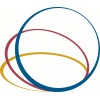
Dual Focus Soft Contact Lens Wear Cessation Study
MyopiaThe purpose of this study is to investigate the effect of ceasing treatment with dual focus soft contact lenses.

Silicone Hydrogel Soft Contact Lens 7-Day Extended Wear Basis
MyopiaThe objective of this study is to evaluate the safety and effectiveness of the Bausch + Lomb samfilcon A soft (hydrophilic) contact lens, a new silicone hydrogel contact lens, compared to the Bausch + Lomb PureVision® soft contact lens when worn for 7-day extended wear by adapted soft contact lens wearers.

DAILIES TOTAL1 Versus ACUVUE TruEye - Effects on the Biology of the Ocular Surface and Lid Margin...
Soft Contact LensesMyopiaThis is a prospective, single center, randomized, bilateral crossover, dispensing clinical trial to evaluate the effects of the water gradient lens, DAILIES TOTAL1, on the biology of corneal epithelium over two months of daily wear compared to wear of a control high oxygen permeable silicone hydrogel daily disposable contact lens, the ACUVUE TruEye; and to correlate these changes with alterations in the lid wiper, tear film and cellular changes at the limbus. The total proposed duration of this study is 12 months to ensure enrollment of up to 94 established contact lens wearers, with anticipated completion of 84. Data will be collected at baseline and following 2 months of daily wear for each lens type. Based upon data from the investigators previous contact lens clinical trials, a 1 month washout period is required prior to initiating lens wear and also between lens wear periods for the two types of lenses in order to eliminate any potential residual solution or lens effects on the corneal epithelium and restore homeostasis. The study is scheduled to commence upon Institutional Review Board approval.

A Study to Evaluate the Safety and Efficacy of a New Silicone Hydrogel Contact Lens Design
MyopiaThe objective of this study is to evaluate the safety and efficacy of a new silicone hydrogel contact lens compared to the Bausch + Lomb PureVision contact lens when worn by adapted soft contact lens wearers.

Study Intended to Evaluate the Safety and Effectiveness of a Johnson & Johnson Vision Care Inc,...
MyopiaStudy in the US intended to evaluate the safety and effectiveness of a Johnson & Johnson Vision Care Inc, (JJVCI) contact lens for use on an extended-wear basis for up to 7 days (6 nights).

Effects of Low Concentration Atropine on Pupillary Size and Accommodative Amplitude
MyopiaTo assess the two-week ocular responses, especially on pupillary size and accommodative amplitude, of nightly application of 0.01% or 0.02% or 0.03% atropine eye drops in children with myopia who were randomized to use of three different low-concentration atropine eye drops

Early Feasibility Study of UV-Femtosecond Laser Assisted Lenticular Extraction
Refractive Error - Myopia SevereRefractive Error - Myopia SimpleThe purpose of this study is to evaluate the initial safety of the UV-FS laser in humans.

The Influence of Atropine on Choroidal Thickness
MyopiaAtropine eye drops are increasingly prescribed for the management of progressive myopia or short-sightedness. A previous study suggested that the back of the eye or choroid may be a part of the mechanism by which it induces its effects. The aim of this study is to characterize the effects of atropine on choroidal thickness and the influence of time of administration (am vs pm). It is hypothesized that the atropine's effect on choroidal thickness will vary with baseline thickness related to diurnal rhythm, where thicker baseline thickness will show a reduced choroidal response.

Contact Lens in Pediatrics (CLIP) in an Asian Population Study
MyopiaTo evaluate the safety, efficacy and physiological performance of daily disposable spherical and toric soft contact lenses in a vision-corrected population of children ages 8-11 years of age. To evaluate the ability of the practitioner to fit these lenses and for the children to wear and manage these lenses.

Effects of Contact Lens Wear on Children's Self-Perceptions
MyopiaThe purpose of the study is to determine whether contact lens wear will improve children's self-perceptions more than spectacle wear.
